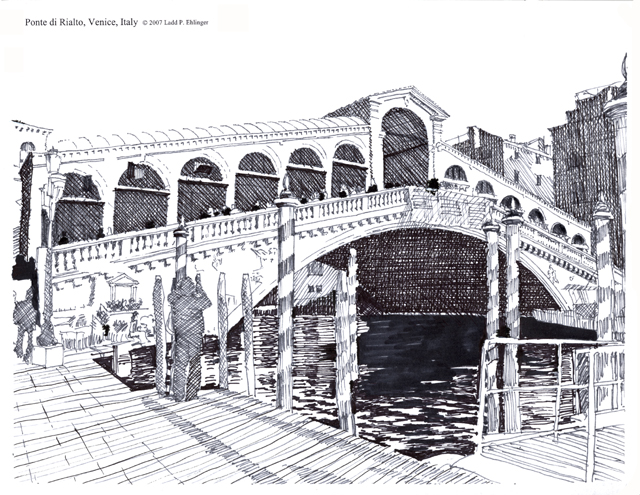
Projects Newsletters Personnel Contact

The Ponte di Rialto (Rialto Bridge) is the main bridge in Venice over the Grand Canal that bisects the islands that comprise the city. This current bridge was designed by Antonio da Ponte (well named architect / engineer) who lived between 1512 and 1597. There were several predecessor bridges, the first having been built c. 1175. This was a wooden bridge and it was replaced several times following its deliberate destruction to isolate and quell uprisings led by Baimonte Tiepolo. There had also been previous bridges that had collapsed, probably from fungus rot, as they also were of wooden structure. At one time Palladio (1508-80) had proposed a three span stone arch bridge in Roman style, which had been rejected due to its impediment to boat traffic and the potential stagnation of the canal water..
The present bridge was the first stone span of the Grand Canal. It is 92 feet (28 M) long and stands 25 feet (7.5 M) high and spans in a single shallow arch to safeguard water flow and boat traffic. There is a central aisle or walkway that is covered, with covered shops formed by thin. delicate Renaissance style arches and barrel vaults and outer aisles on either side terminated by a strong balustrade. In the center of the rise is a cross vault that stands higher and interrupts the aisles as a focal point in the middle.
The Rialto was the only bridge over the Grand Canal until the mid 19th century when the Accademia and Scalzi bridges were built. Besides water transport as a means of getting around from island to island in Venice, walking is the main method of getting around. The boats are also slow, slower than walking. There are no automobiles whatsoever. Nor any motorscooters, or motor cycles, or bicycles. One has only one’s feet to depend upon. It goes beyond simply walking on one level because of the plethora of bridges. Each bridge is actually a staircase. To provide for the boats, there has to be a sufficient rise in the bridge’s span to clear the boats, which means that it is really a double staircase -- one flight up and one flight down. You get a lot of exercise moving about Venice!